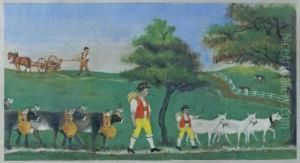Josef Anton Moser Paintings
Josef Anton Moser was a notable figure in the world of European art, particularly in the realm of fresco and oil painting during the 18th century. Born in 1701, Moser's contributions to art were part of the broader Baroque and Rococo movements that characterized the period, known for their elaborate ornamentation, dynamic movements, and dramatic use of light and shadow. Despite the prominence of these styles, detailed records of Moser's life and works are relatively scarce, reflecting the broader challenge of art historical documentation for many artists of the era.
Moser's artistic journey was marked by the typical apprenticeship model of the time, where young artists learned their craft under the guidance of established masters. This period of his life was crucial for developing the skills and stylistic approaches that would define his later works. His art often depicted religious and mythological themes, a common choice for the period, which were imbued with a sense of movement and emotional depth characteristic of the Baroque sensibility.
Over his career, Moser traveled across various European centers, contributing to the rich tapestry of 18th-century art through commissions for both religious institutions and noble patrons. His frescoes adorned the walls and ceilings of churches and palaces, captivating viewers with their vibrant colors and intricate details. These works not only demonstrated his mastery of the medium but also his ability to weave complex narratives into visual form.
Despite the challenges in piecing together a comprehensive view of Josef Anton Moser's life and oeuvre, the artist's surviving works continue to be studied and admired for their technical skill and aesthetic beauty. Moser's death in 1780 marked the end of a prolific career, but his artistic legacy endures, offering insight into the rich artistic landscape of 18th-century Europe. His contributions to the Baroque and Rococo movements remain a testament to his talent and creativity, ensuring his place in the annals of art history.
